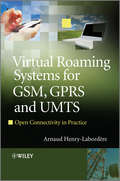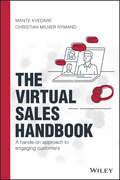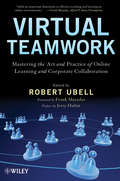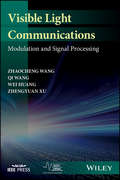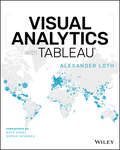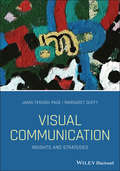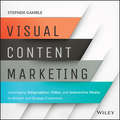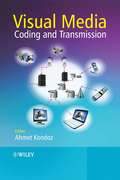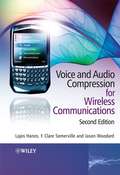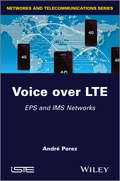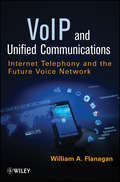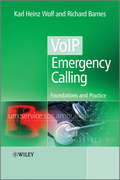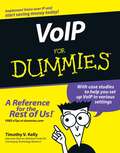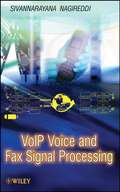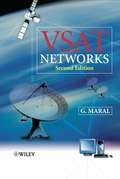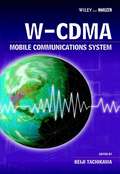- Table View
- List View
Virtual Roaming Systems for GSM, GPRS and UMTS: Open Connectivity in Practice
by Arnaud Henry-LabordereThis book provides a detailed technical guide to the virtual and optimised roaming systems for mobile networks Written by a pioneer in the field, this book focuses on the implementation of virtual roaming systems. It generalizes the previous SS7 SMS interworking architectures to voice and data, GPRS, and 3G virtual roaming; extending the discussion of virtual roaming to include location based services, optimal routing and 4G perspectives. The author provides a thorough and detailed technical explanation of the topic covering subjects such as ‘Over the Air’ (OTA) provisioning and detailed geo-localisation systems in a virtual roaming environment. Finally, this book addresses the application of MAP, CAMEL, TCAP, SCCP, and GTP. Key Features: Provides a thorough and detailed technical coverage of virtual and optimised roaming systems for mobile networks Explores the application of MAP, CAMEL, TCAP, SCCP, and GTP Discusses previous SMS Hubs architecture used for SMS interworking and generalises to voice, data, and 3G virtual roaming Includes material on pre-paid case with CAMEL parameter transformations, SMS, Supplementary Services and USSD implementation Focuses on roaming hubs (including an, introduction to Sigtran configuration) and transparent networks of hubs This book will serve as an invaluable reference for network and networking engineers, handset developers, systems implementers, systems integrators, systems software engineers and programmers, wireless specialists and anybody else seeking a comprehensive and practical guide to the basics of virtual roaming systems.
The Virtual Sales Handbook: A Hands-on Approach to Engaging Customers
by Mante Kvedare Christian Milner NymandLearn to engage your B2B customers through effective virtual sales meetings and presentations The global COVID-19 pandemic has radically changed how business-to-business companies interact with their customers. The traditional face-to-face meeting has quickly become a thing of the past—the virtual customer engagement model is the new normal. To secure existing and future revenue streams in the virtual B2B sales environment, companies must equip their commercial frontline with the confidence, skills, and tools necessary for effectively engaging customers virtually. The Virtual Sales Handbook: A Hands-on Approach to Engaging Customers is designed for sales reps, commercial managers, customer relationship managers, and other customer-facing professionals working in the virtual realm. Step-by-step, readers learn to prepare for a virtual sales meeting, create compelling virtual presentations, build energy through effective openers, develop trust in the virtual world, drive impact through virtual meeting follow-up, and much more. Throughout the book, readers are provided with an abundance of tips and tricks, illustrative examples and case studies, and actionable strategies based on extensive implementation and upskilling experience. Written by two authors with deep knowledge and expertise in operationalizing virtual commercial sales and marketing methods and tools, this must-have guide will help you: Navigate the world of virtual sales Overcome the barriers of virtual customer interaction Evaluate the strengths and weaknesses of different virtual sales models Plan and execute effective virtual sales meetings Build engaging storylines and presentations Lead the transformation from physical to virtual sales Leverage effective virtual customer engagement techniques The Virtual Sales Handbook: A Hands-on Approach to Engaging Customers is an indispensable resource for C-suite executives, business leaders, senior sales managers, sales representatives, account managers, and anyone on the commercial frontline.
The Virtual Sales Handbook: A Hands-on Approach to Engaging Customers
by Mante Kvedare Christian Milner NymandLearn to engage your B2B customers through effective virtual sales meetings and presentations The global COVID-19 pandemic has radically changed how business-to-business companies interact with their customers. The traditional face-to-face meeting has quickly become a thing of the past—the virtual customer engagement model is the new normal. To secure existing and future revenue streams in the virtual B2B sales environment, companies must equip their commercial frontline with the confidence, skills, and tools necessary for effectively engaging customers virtually. The Virtual Sales Handbook: A Hands-on Approach to Engaging Customers is designed for sales reps, commercial managers, customer relationship managers, and other customer-facing professionals working in the virtual realm. Step-by-step, readers learn to prepare for a virtual sales meeting, create compelling virtual presentations, build energy through effective openers, develop trust in the virtual world, drive impact through virtual meeting follow-up, and much more. Throughout the book, readers are provided with an abundance of tips and tricks, illustrative examples and case studies, and actionable strategies based on extensive implementation and upskilling experience. Written by two authors with deep knowledge and expertise in operationalizing virtual commercial sales and marketing methods and tools, this must-have guide will help you: Navigate the world of virtual sales Overcome the barriers of virtual customer interaction Evaluate the strengths and weaknesses of different virtual sales models Plan and execute effective virtual sales meetings Build engaging storylines and presentations Lead the transformation from physical to virtual sales Leverage effective virtual customer engagement techniques The Virtual Sales Handbook: A Hands-on Approach to Engaging Customers is an indispensable resource for C-suite executives, business leaders, senior sales managers, sales representatives, account managers, and anyone on the commercial frontline.
Virtual Teamwork: Mastering the Art and Practice of Online Learning and Corporate Collaboration
by Jerry Hultin"This book, by Robert Ubell and his excellent team of collaborators, adds an important dimension to effective teaching and learning in online environments. It addresses how interaction and collaboration online can be effectively harnessed in virtual teams. It is an important contribution to the larger field of Internet-based education." —Frank Mayadas, Alfred P. Sloan Foundation How to create and manage highly successful teams online With the advent of the global economy and high-speed Internet, online collaboration is fast becoming the norm in education and industry. This book takes online collaboration to the next level, showing how you can bolster online learning and business performance with the innovative use of virtual teams. Written by a team of experts headed by online learning pioneer Robert Ubell, Virtual Teamwork covers best practices for online instruction and team learning, reveals proven techniques for managing enterprise and global virtual teams, and helps you choose the best communication tools for the job. Educators, project managers, and anyone involved in teaching online courses or creating online programs will find a wealth of tips and techniques for building and managing successful virtual teams, including guidance for: Integrating team instruction in the virtual classroom Using best techniques for team interaction across borders and time zones Structuring cost-effective, competitive projects that work Leveraging leadership, mentoring, and conflict management in virtual teams Conducting testing, grading, and peer- and self-assessment online Managing corporate, global, and engineering virtual teams Choosing the right technologies for effective collaboration
Virtual Teamwork: Mastering the Art and Practice of Online Learning and Corporate Collaboration
by Jerry Hultin"This book, by Robert Ubell and his excellent team of collaborators, adds an important dimension to effective teaching and learning in online environments. It addresses how interaction and collaboration online can be effectively harnessed in virtual teams. It is an important contribution to the larger field of Internet-based education." —Frank Mayadas, Alfred P. Sloan Foundation How to create and manage highly successful teams online With the advent of the global economy and high-speed Internet, online collaboration is fast becoming the norm in education and industry. This book takes online collaboration to the next level, showing how you can bolster online learning and business performance with the innovative use of virtual teams. Written by a team of experts headed by online learning pioneer Robert Ubell, Virtual Teamwork covers best practices for online instruction and team learning, reveals proven techniques for managing enterprise and global virtual teams, and helps you choose the best communication tools for the job. Educators, project managers, and anyone involved in teaching online courses or creating online programs will find a wealth of tips and techniques for building and managing successful virtual teams, including guidance for: Integrating team instruction in the virtual classroom Using best techniques for team interaction across borders and time zones Structuring cost-effective, competitive projects that work Leveraging leadership, mentoring, and conflict management in virtual teams Conducting testing, grading, and peer- and self-assessment online Managing corporate, global, and engineering virtual teams Choosing the right technologies for effective collaboration
Visible Light Communications: Modulation and Signal Processing (IEEE Series on Digital & Mobile Communication)
by Zhaocheng Wang Qi Wang Wei Huang Zhengyuan XuA complete and comprehensive reference on modulation and signal processing for visible light communication This informative new book on state-of-the-art visible light communication (VLC) provides, for the first time, a systematical and advanced treatment of modulation and signal processing for VLC. Visible Light Communications: Modulation and Signal Processing offers a practical guide to designing VLC, linking academic research with commercial applications. In recent years, VLC has attracted attention from academia and industry since it has many advantages over the traditional radio frequency, including wide unregulated bandwidth, high security, and low cost. It is a promising complementary technique in 5G and beyond wireless communications, especially in indoor applications. However, lighting constraints have not been fully considered in the open literature when considering VLC system design, and its importance has been underestimated. That’s why this book—written by a team of experts with both academic research experience and industrial development experience in the field—is so welcome. To help readers understand the theory and design of VLC systems, the book: Details many modern techniques on both modulation and signal processing aspects Links academic research with commercial applications in visible light communications as well as other wireless communication systems Combines theoretical rigor with practical examples in presenting optical camera communication systems Visible Light Communications: Modulation and Signal Processing serves as a useful tool and reference book for visible light communication professionals, as well as wireless communication system professionals and project managers. It is also an important guide for undergraduates and graduates who want to conduct research in areas of wireless communications.
Visible Light Communications: Modulation and Signal Processing (IEEE Series on Digital & Mobile Communication)
by Zhaocheng Wang Qi Wang Wei Huang Zhengyuan XuA complete and comprehensive reference on modulation and signal processing for visible light communication This informative new book on state-of-the-art visible light communication (VLC) provides, for the first time, a systematical and advanced treatment of modulation and signal processing for VLC. Visible Light Communications: Modulation and Signal Processing offers a practical guide to designing VLC, linking academic research with commercial applications. In recent years, VLC has attracted attention from academia and industry since it has many advantages over the traditional radio frequency, including wide unregulated bandwidth, high security, and low cost. It is a promising complementary technique in 5G and beyond wireless communications, especially in indoor applications. However, lighting constraints have not been fully considered in the open literature when considering VLC system design, and its importance has been underestimated. That’s why this book—written by a team of experts with both academic research experience and industrial development experience in the field—is so welcome. To help readers understand the theory and design of VLC systems, the book: Details many modern techniques on both modulation and signal processing aspects Links academic research with commercial applications in visible light communications as well as other wireless communication systems Combines theoretical rigor with practical examples in presenting optical camera communication systems Visible Light Communications: Modulation and Signal Processing serves as a useful tool and reference book for visible light communication professionals, as well as wireless communication system professionals and project managers. It is also an important guide for undergraduates and graduates who want to conduct research in areas of wireless communications.
Visual Analytics with Tableau
by Alexander LothA four-color journey through a complete Tableau visualization Tableau is a popular data visualization tool that’s easy for individual desktop use as well as enterprise. Used by financial analysts, marketers, statisticians, business and sales leadership, and many other job roles to present data visually for easy understanding, it’s no surprise that Tableau is an essential tool in our data-driven economy. Visual Analytics with Tableau is a complete journey in Tableau visualization for a non-technical business user. You can start from zero, connect your first data, and get right into creating and publishing awesome visualizations and insightful dashboards. • Learn the different types of charts you can create • Use aggregation, calculated fields, and parameters • Create insightful maps • Share interactive dashboards Geared toward beginners looking to get their feet wet with Tableau, this book makes it easy and approachable to get started right away.
Visual Analytics with Tableau
by Alexander LothA four-color journey through a complete Tableau visualization Tableau is a popular data visualization tool that’s easy for individual desktop use as well as enterprise. Used by financial analysts, marketers, statisticians, business and sales leadership, and many other job roles to present data visually for easy understanding, it’s no surprise that Tableau is an essential tool in our data-driven economy. Visual Analytics with Tableau is a complete journey in Tableau visualization for a non-technical business user. You can start from zero, connect your first data, and get right into creating and publishing awesome visualizations and insightful dashboards. • Learn the different types of charts you can create • Use aggregation, calculated fields, and parameters • Create insightful maps • Share interactive dashboards Geared toward beginners looking to get their feet wet with Tableau, this book makes it easy and approachable to get started right away.
Visual Communication: Insights and Strategies
by Janis Teruggi Page Margaret DuffyTeaches visual literacy, theory, scholarly critique, and practical application of visuals in professional communication careers Based on years of research, Visual Communication Insights and Strategies explores visual imagery in advertising, news coverage, political discourse, popular culture, and digital and social media technologies. It is filled with insights into the role of visuals in our dynamic social environment and contains strategies on how to use them. The authors teach theoretically-informed literacy and critical analysis of visual communication and show how to assess and apply this knowledge in the fields of advertising, public relations, journalism, organizational communication, and intercultural communication. This important book: Reveals how to analyze visual imagery Contains a research-based approach to the topic Introduces a 3-step process, Research-Evaluate-Create, to apply the knowledge gained Combines research, theory, and professional practice of visual communication Designed for undergraduate and graduate courses in visual communication courses, as well as visual rhetoric, visual literacy, and visual culture, Visual Communication Insights and Strategies reveals how to apply rhetorical theories to visual imagery.
Visual Content Marketing: Leveraging Infographics, Video, and Interactive Media to Attract and Engage Customers
by Stephen GambleYour ticket to generating better results through infographics Visual Content Marketing is a more than just a guide to infographics. Written for business people dealing with complex offerings, this is a hands-on, in-the-trenches guide to leveraging this emerging medium to reach bottomline business goals. Uniquely, this book addresses the full range of visual solutions, with an emphasis on using these products to create real business value. Inside, you'll learn the ins and outs of infographics, interactive pictograms, video, animations, data-driven visualizations, and other conversion-generating graphical content. Get inspired by the groundbreaking examples showcased here, and learn how to manage every aspect of visual content, from sourcing suppliers to leveraging content on the appropriate media platforms. Author Stephen Gamble is a leader in visual marketing solutions, with over twenty years of experience in the industry. Thousands look to his firm, Frame Concepts, for insider tips on generating revenue with the help of innovative graphics. This insider knowledge is at your fingertips in Visual Content Marketing. To meet your demanding business goals, you need new ideas. This book will show you how to infuse visual content where and when it counts. Generate high-quality leads and revenue with infographics, video, data visualizations, and more Identify the visual marketing and engagement strategies that will work for your business Source and manage talented content suppliers who will deliver on your strategic vision Integrate eye-popping visual solutions to update your brand and achieve your business goals Focusing on the visual is the secret to success in the effort to win customer engagement and attention. Visual Content Marketing is applicable to every business function and industry. With this book, you have the start-to-finish information you need to leverage visual solutions to great effect.
Visual Content Marketing: Leveraging Infographics, Video, and Interactive Media to Attract and Engage Customers
by Stephen GambleYour ticket to generating better results through infographics Visual Content Marketing is a more than just a guide to infographics. Written for business people dealing with complex offerings, this is a hands-on, in-the-trenches guide to leveraging this emerging medium to reach bottomline business goals. Uniquely, this book addresses the full range of visual solutions, with an emphasis on using these products to create real business value. Inside, you'll learn the ins and outs of infographics, interactive pictograms, video, animations, data-driven visualizations, and other conversion-generating graphical content. Get inspired by the groundbreaking examples showcased here, and learn how to manage every aspect of visual content, from sourcing suppliers to leveraging content on the appropriate media platforms. Author Stephen Gamble is a leader in visual marketing solutions, with over twenty years of experience in the industry. Thousands look to his firm, Frame Concepts, for insider tips on generating revenue with the help of innovative graphics. This insider knowledge is at your fingertips in Visual Content Marketing. To meet your demanding business goals, you need new ideas. This book will show you how to infuse visual content where and when it counts. Generate high-quality leads and revenue with infographics, video, data visualizations, and more Identify the visual marketing and engagement strategies that will work for your business Source and manage talented content suppliers who will deliver on your strategic vision Integrate eye-popping visual solutions to update your brand and achieve your business goals Focusing on the visual is the secret to success in the effort to win customer engagement and attention. Visual Content Marketing is applicable to every business function and industry. With this book, you have the start-to-finish information you need to leverage visual solutions to great effect.
Visual Media Coding and Transmission
by Ahmet KondozThis book presents the state-of-the-art in visual media coding and transmission Visual Media Coding and Transmission is an output of VISNET II NoE, which is an EC IST-FP6 collaborative research project by twelve esteemed institutions from across Europe in the fields of networked audiovisual systems and home platforms. The authors provide information that will be essential for the future study and development of visual media communications technologies. The book contains details of video coding principles, which lead to advanced video coding developments in the form of Scalable Coding, Distributed Video Coding, Non-Normative Video Coding Tools and Transform Based Multi-View Coding. Having detailed the latest work in Visual Media Coding, networking aspects of Video Communication is detailed. Various Wireless Channel Models are presented to form the basis for both link level quality of service (QoS) and cross network transmission of compressed visual data. Finally, Context-Based Visual Media Content Adaptation is discussed with some examples. Key Features: Contains the latest advances in this important field covered by VISNET II NoE Addresses the latest multimedia signal processing and coding algorithms Covers all important advance video coding techniques, scalable and multiple description coding, distributed video coding and non-normative tools Discusses visual media networking with various wireless channel models QoS methods by way of link adaptation techniques are detailed with examples Presents a visual media content adaptation platform, which is both context aware and digital rights management enabled Contains contributions from highly respected academic and industrial organizations Visual Media Coding and Transmission will benefit researchers and engineers in the wireless communications and signal processing fields. It will also be of interest to graduate and PhD students on media processing, coding and communications courses.
Voice and Audio Compression for Wireless Communications
by Lajos Hanzo F. Clare Somerville Jason WoodardVoice communications remains the most important facet of mobile radio services, which may be delivered over conventional fixed links, the Internet or wireless channels. This all-encompassing volume reports on the entire 50-year history of voice compression, on recent audio compression techniques and the protection as well as transmission of these signals in hostile wireless propagation environments. Audio and Voice Compression for Wireless and Wireline Communications, Second Edition is divided into four parts with Part I covering the basics, while Part II outlines the design of analysis-by-synthesis coding, including a 100-page chapter on virtually all existing standardised speech codecs. The focus of Part III is on wideband and audio coding as well as transmission. Finally, Part IV concludes the book with a range of very low rate encoding techniques, scanning a range of research-oriented topics. Fully updated and revised second edition of “Voice Compression and Communications”, expanded to cover Audio features Includes two new chapters, on narrowband and wideband AMR coding, and MPEG audio coding Addresses the new developments in the field of wideband speech and audio compression Covers compression, error resilience and error correction coding, as well as transmission aspects, including cutting-edge turbo transceivers Presents both the historic and current view of speech compression and communications. Covering fundamental concepts in a non-mathematical way before moving to detailed discussions of theoretical principles, future concepts and solutions to various specific wireless voice communication problems, this book will appeal to both advanced readers and those with a background knowledge of signal processing and communications.
Voice over LTE: EPS and IMS Networks (Iste Ser.)
by André PérezVoice over LTE (Long Term Evolution) presents the mechanisms put in place in 4G mobile networks for the transportation of IP packets containing voice data and telephone signaling, as well as the technologies used to provide a telephone service in the IMS (IP Multimedia Sub-system) network. Despite the difficulty connected to the handover of the 4G network to the 2G/3G network, a telephone communication will not be established on the 4G network. This book analyzes the technologies that have been put in place, such as CSFB (Circuit Service FallBack), an interim solution that enables a mobile connected to the 4G network to receive an alert transmitted by the 2G/3G network. The book also goes on to develop the SIP (Session Information Protocol) on which the telephone signaling transferred by the 4G network is based, the IMS network that provides the service and defines the routing, the SRVCC (Single Radio Voice Call Continuity) mechanism that maintains communication and the TAS (Telephony Application Server) that supplies supplementary services. Contents 1. The EPS Network. 2. The LTE Interface. 3. The CSFB Function. 4. SIP and SDP Protocols. 5. The IMS Network. 6. Telephone Services. 7. The SRVCC Function. About the Authors André Perez is a consultant and teacher in networks and telecommunications. He works with industrialists and operators regarding architecture studies and leads training on the 4G and IMS networks for NEXCOM.
Voice over LTE: EPS and IMS Networks
by André PérezVoice over LTE (Long Term Evolution) presents the mechanisms put in place in 4G mobile networks for the transportation of IP packets containing voice data and telephone signaling, as well as the technologies used to provide a telephone service in the IMS (IP Multimedia Sub-system) network. Despite the difficulty connected to the handover of the 4G network to the 2G/3G network, a telephone communication will not be established on the 4G network. This book analyzes the technologies that have been put in place, such as CSFB (Circuit Service FallBack), an interim solution that enables a mobile connected to the 4G network to receive an alert transmitted by the 2G/3G network. The book also goes on to develop the SIP (Session Information Protocol) on which the telephone signaling transferred by the 4G network is based, the IMS network that provides the service and defines the routing, the SRVCC (Single Radio Voice Call Continuity) mechanism that maintains communication and the TAS (Telephony Application Server) that supplies supplementary services. Contents 1. The EPS Network. 2. The LTE Interface. 3. The CSFB Function. 4. SIP and SDP Protocols. 5. The IMS Network. 6. Telephone Services. 7. The SRVCC Function. About the Authors André Perez is a consultant and teacher in networks and telecommunications. He works with industrialists and operators regarding architecture studies and leads training on the 4G and IMS networks for NEXCOM.
VoIP and Unified Communications: Internet Telephony and the Future Voice Network
by William A. FlanaganTranslates technical jargon into practical business communications solutions This book takes readers from traditional voice, fax, video, and data services delivered via separate platforms to a single, unified platform delivering all of these services seamlessly via the Internet. With its clear, jargon-free explanations, the author enables all readers to better understand and assess the growing number of voice over Internet protocol (VoIP) and unified communications (UC) products and services that are available for businesses. VoIP and Unified Communications is based on the author's careful review and synthesis of more than 7,000 pages of published standards as well as a broad range of datasheets, websites, white papers, and webinars. It begins with an introduction to IP technology and then covers such topics as: Packet transmission and switching VoIP signaling and call processing How VoIP and UC are defining the future Interconnections with global services Network management for VoIP and UC This book features a complete chapter dedicated to cost analyses and payback calculations, enabling readers to accurately determine the short- and long-term financial impact of migrating to various VoIP and UC products and services. There's also a chapter detailing major IP systems hardware and software. Throughout the book, diagrams illustrate how various VoIP and UC components and systems work. In addition, the author highlights potential problems and threats to UC services, steering readers away from common pitfalls. Concise and to the point, this text enables readers—from novices to experienced engineers and technical managers—to understand how VoIP and UC really work so that everyone can confidently deal with network engineers, data center gurus, and top management.
VoIP and Unified Communications: Internet Telephony and the Future Voice Network
by William A. FlanaganTranslates technical jargon into practical business communications solutions This book takes readers from traditional voice, fax, video, and data services delivered via separate platforms to a single, unified platform delivering all of these services seamlessly via the Internet. With its clear, jargon-free explanations, the author enables all readers to better understand and assess the growing number of voice over Internet protocol (VoIP) and unified communications (UC) products and services that are available for businesses. VoIP and Unified Communications is based on the author's careful review and synthesis of more than 7,000 pages of published standards as well as a broad range of datasheets, websites, white papers, and webinars. It begins with an introduction to IP technology and then covers such topics as: Packet transmission and switching VoIP signaling and call processing How VoIP and UC are defining the future Interconnections with global services Network management for VoIP and UC This book features a complete chapter dedicated to cost analyses and payback calculations, enabling readers to accurately determine the short- and long-term financial impact of migrating to various VoIP and UC products and services. There's also a chapter detailing major IP systems hardware and software. Throughout the book, diagrams illustrate how various VoIP and UC components and systems work. In addition, the author highlights potential problems and threats to UC services, steering readers away from common pitfalls. Concise and to the point, this text enables readers—from novices to experienced engineers and technical managers—to understand how VoIP and UC really work so that everyone can confidently deal with network engineers, data center gurus, and top management.
VoIP Emergency Calling: Foundations and Practice
by Karl Heinz Wolf Richard BarnesThis book provides a comprehensive view of the emerging standards for VoIP emergency calling from an International perspective In this book, the authors provide a treatment of the VoIP emergency calling process that is both comprehensive, looking at all aspects of emergency calling, and practical, providing technical details on how such functions can be implemented. In addition, the authors describe the standardization efforts of the Internet Engineering Task Force who are currently working to improve the situation for VoIP emergency calls. The book provides an overview of emergency calling with a particular focus on the ECRIT emergency calling architecture, and discusses considerations related to implementation, deployment, and regulation of next-generation emergency calling. It also takes a look at practical aspects of emergency calling, with a set of exercises to help the reader get familiar with the technologies involved. Key Features: Comprehensive view of emerging standards for VoIP emergency calling from an international perspective Practical guides for implementing the core of the emergency calling architecture Architectural, practical, and regulatory perspectives Written by experts working on the development of emergency calling architectures and its implementation Includes an accompanying website with open-source software packages (http://www.voip-sos.net/) This book will be an invaluable resource for product managers and developers, equipment vendors, network operators, emergency service providers, and telecommunications regulators. Industry professionals interested in standards compliance will also find this book of interest.
VoIP Emergency Calling: Foundations and Practice
by Karl Heinz Wolf Richard BarnesThis book provides a comprehensive view of the emerging standards for VoIP emergency calling from an International perspective In this book, the authors provide a treatment of the VoIP emergency calling process that is both comprehensive, looking at all aspects of emergency calling, and practical, providing technical details on how such functions can be implemented. In addition, the authors describe the standardization efforts of the Internet Engineering Task Force who are currently working to improve the situation for VoIP emergency calls. The book provides an overview of emergency calling with a particular focus on the ECRIT emergency calling architecture, and discusses considerations related to implementation, deployment, and regulation of next-generation emergency calling. It also takes a look at practical aspects of emergency calling, with a set of exercises to help the reader get familiar with the technologies involved. Key Features: Comprehensive view of emerging standards for VoIP emergency calling from an international perspective Practical guides for implementing the core of the emergency calling architecture Architectural, practical, and regulatory perspectives Written by experts working on the development of emergency calling architectures and its implementation Includes an accompanying website with open-source software packages (http://www.voip-sos.net/) This book will be an invaluable resource for product managers and developers, equipment vendors, network operators, emergency service providers, and telecommunications regulators. Industry professionals interested in standards compliance will also find this book of interest.
VoIP For Dummies
by Timothy V. KellyPut your phone system on your computer network and see the savings See how to get started with VoIP, how it works, and why it saves you money VoIP is techspeak for "voice over Internet protocol," but it could spell "saving big bucks" for your business! Here's where to get the scoop in plain English. Find out how VoIP can save you money, how voice communication travels online, and how to choose the best way to integrate your phone system with your network at home or at the office. Discover how to: Use VoIP for your business or home phone service Choose the best network type Set up VoIP on a wireless network Understand transports and services Demonstrate VoIP's advantages to management
VoIP For Dummies
by Timothy V. KellyPut your phone system on your computer network and see the savings See how to get started with VoIP, how it works, and why it saves you money VoIP is techspeak for "voice over Internet protocol," but it could spell "saving big bucks" for your business! Here's where to get the scoop in plain English. Find out how VoIP can save you money, how voice communication travels online, and how to choose the best way to integrate your phone system with your network at home or at the office. Discover how to: Use VoIP for your business or home phone service Choose the best network type Set up VoIP on a wireless network Understand transports and services Demonstrate VoIP's advantages to management
VoIP Voice and Fax Signal Processing
by Sivannarayana NagireddiA complete and systematic treatment of signal processing for VoIP voice and fax This book presents a consolidated view and basic approach to signal processing for VoIP voice and fax solutions. It provides readers with complete coverage of the topic, from how things work in voice and fax modules, to signal processing aspects, implementation, and testing. Beginning with an overview of VoIP infrastructure, interfaces, and signals, the book systematically covers: Voice compression Packet loss concealment techniques DTMF detection, generation, and rejection Wideband voice modules operation VoIP Voice-Network bit rate calculations VoIP voice testing Fax over IP and modem over IP Country deviations of PSTN mapped to VoIP VoIP on different processors and architectures Generic VAD-CNG for waveform codecs Echo cancellation Caller ID features in VoIP Packetization—RTP, RTCP, and jitter buffer Clock sources for VoIP applications Fax operation on PSTN, modulations, and fax messages Fax over IP payload formats and bit rate calculations Voice packets jitter with large data packets VoIP voice quality Over 100 questions and answers on voice and more than seventy questions and answers on fax are provided at the back of the book to reinforce the topics covered throughout the text. Additionally, several clarification, interpretation, and discussion sections are included in selected chapters to aide in readers' comprehension. VoIP Voice and Fax Signal Processing is an indispensable resource for professional electrical engineers, voice and fax solution developers, product and deployment support teams, quality assurance and test engineers, and computer engineers. It also serves as a valuable textbook for graduate-level students in electrical engineering and computer engineering courses.
VSAT Networks
by Gerard MaralVSAT Networks: Second Edition covers all the important issues involved with the installation of VSAT systems.Since the first edition was published, the VSAT market has continued to expand steadily. VSAT technologies have advanced, prompting an increase in the take-up of VSAT services.Offering a comprehensive introduction to the topic followed by a detailed exploration of multiple access protocols, delay analysis and system dimensioning, this edition is a highly relevant update of VSAT Networks. Written by a well respected and established member of the satellite community, it will be welcomed be academics and engineers alike. Covers important issues of services, economics and regulatory aspects Provides a detailed technical insight on networking and radio frequency link aspects, therefore addressing the specific features of VSAT networks at the three lower layers of the OSI Reference Layer Model for data communications This timely second edition is fully updated with new figures, improvements and revised chapter on future developments This book will appeal to students of telecommunications, electronics and computer science. Practising telecommunications engineers and technical managers involved in the planning, design and operation of VSAT networks and systems will also find this book a valuable reference source.
W-CDMA: Mobile Communications System
by Keiji TachikawaThe evolution of cellular based mobile communication systems, from the first generation (analogue) to the second generation (digital), has been made possible by solving many technical issues along the way. Efforts to develop a global standard for providing high-speed, high quality multimedia services have crystallised in the form of the third generation (3G) systems under the IMT 200 standard. The world's first 3G system has been implemented by Japan based on the latest research results and other countries are expected to follow from 2002 onwards. 3G systems are expected to bring about radical socio-economic and cultural changes that would affect people around the world. This volume reviews in detail the basic technologies applied to W-CDMA, a standard 3G mobile communications technology. The focus is to explain in layman's language the technologies that will play an important part in future developments, with reference to the latest research results.
